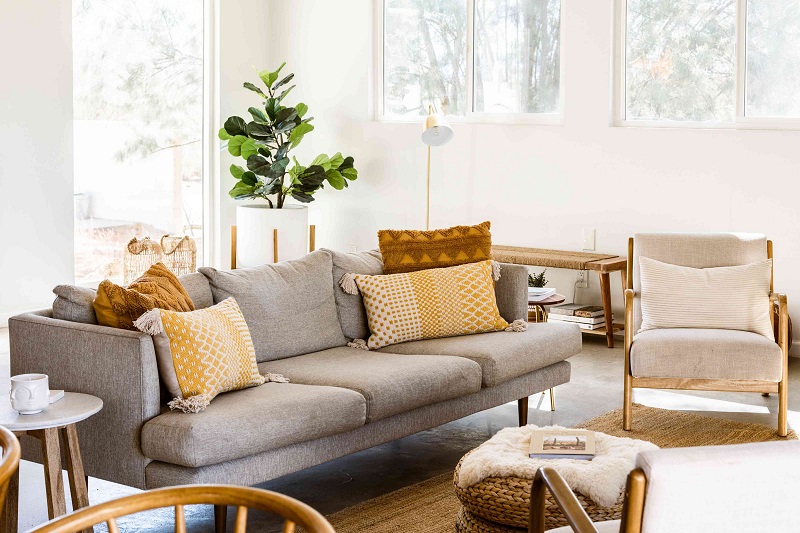Creating a warm and inviting home is an art. It’s about crafting an environment where you feel comfortable and relaxed, a space that reflects your personality and provides a sense of comfort. One of the most effective ways to achieve this is through layering textures. Textures add depth, warmth, and interest to a room, creating a space that is not only visually appealing but also feels cozy and welcoming.
From the softness of plush rugs to the sleekness of polished wood, layering different textures in your decor allows you to play with contrast, harmony, and tactile experiences. Whether you’re designing a living room, bedroom, or even a hallway, here’s how you can master the art of layering textures to transform your home into a warm, inviting retreat.
1. Start with a Base: Flooring and Walls
When layering textures, it’s important to first establish your foundational elements, such as flooring and walls. These large, static surfaces will anchor the rest of your textures.
- Flooring: The texture of your floor sets the tone for the entire room. Hardwood floors or sleek tiles give a clean, polished foundation, but they can feel cold without the addition of soft textures. Consider layering a plush rug or a woven throw rug to add warmth and comfort. Opt for a rug with a natural fiber like jute or wool for a tactile contrast against hardwood or tile floors. A cozy area rug will also help to define different zones within an open-plan living area.
- Walls: While walls are typically smooth, you can introduce texture through paint, wallpaper, or wall art. Textured wall finishes, such as grasscloth wallpaper or a painted accent wall, can help create a sense of depth. Even incorporating textiles like a woven tapestry or fabric wall hangings can introduce warmth and visual interest to your walls, making the space feel cozier and more welcoming.
2. Add Soft Furnishings: Pillows and Throws
One of the easiest and most effective ways to layer textures in your living room or bedroom is through soft furnishings. Think pillows, throws, blankets, and cushions. These accessories allow you to mix different textures without overwhelming the space.
- Pillows: Throw pillows are a simple yet impactful way to introduce varied textures into your decor. You can mix and match different fabrics, such as velvet, linen, faux fur, and leather, to create a contrast of softness, sheen, and structure. A velvet pillow against a linen sofa adds luxurious depth, while a faux fur cushion can introduce warmth and coziness. Play around with different shapes and sizes to create a curated yet comfortable look.
- Throws: A textured throw blanket draped over the arm of your couch or at the foot of your bed can bring immediate warmth and personality to a room. Wool, chunky knit, and cashmere throws are excellent choices for cooler months, while lighter linen or cotton throws work well in warmer seasons. The texture of the fabric adds tactile interest while also creating a visual contrast to other elements in the room.
3. Introduce Natural Elements: Wood, Stone, and Plants
Natural materials can help soften the overall feel of a room while adding texture. Incorporating wood, stone, and plants into your home creates an organic, grounded vibe that is essential for a warm, inviting space.
- Wood: The natural grain of wood brings warmth and texture into a space. Whether you choose a wooden coffee table, bookshelves, or a wooden-framed mirror, the warmth of the material creates contrast against softer textures like fabrics. Choosing furniture with an aged or distressed wood finish can add an element of rustic charm and comfort.
- Stone: Natural stone, such as marble, granite, or slate, can introduce a touch of sophistication and texture. A stone countertop, a decorative stone bowl, or a stone fireplace surround adds an elegant tactile element to your home. For a cozier feel, you might also consider adding a stone accent wall in the form of exposed brick or stone veneer.
- Plants: Adding greenery to your home not only brings life and color to a room but also introduces a refreshing texture. From the smooth, waxy leaves of succulents to the frilly edges of ferns, plants create an organic, textural contrast to your furniture and decor. Plus, the natural textures of plants can help soften the more structured, geometric elements in the room.
4. Incorporate Different Fabrics and Materials
Layering different types of fabrics and materials creates depth and richness. Think of how leather contrasts with velvet or linen complements wool. Experiment with different fabric choices to enhance the texture profile in your space.
- Leather and Velvet: Leather furniture pieces, such as a sofa or armchair, have a sleek, polished texture that feels sophisticated and timeless. Pairing leather with soft, plush fabrics like velvet can create a beautiful contrast. A velvet throw pillow or a velvet chair in a deep, rich color like navy or burgundy can add a touch of luxury to the room while balancing the smoothness of leather.
- Wool and Linen: Wool, particularly in the form of a woven throw or cozy rug, is a perfect way to bring in texture during the cooler months. It pairs beautifully with lighter fabrics like linen, which is perfect for warmer months and adds an airy feel to the space. A linen curtain can create a breezy, relaxed atmosphere, while a wool blanket brings comfort and warmth.
- Metal and Glass: Don’t forget the reflective textures of metal and glass. Incorporating metallic elements, like a brass lamp, a gold-framed mirror, or silver-toned picture frames, adds a touch of sparkle and dimension to your decor. The smoothness of glass and the gleam of metal can provide balance against rougher, more organic textures like wood or fabric.
5. Furniture Pieces That Blend Function and Style
When layering textures, your choice of furniture is just as important as the materials you select. Different furniture pieces can introduce both texture and function into a room. Consider investing in high-quality pieces that combine comfort with visual interest.
- Sofas and Chairs: Your sofa is often the focal point of the living room, so choosing one with interesting textures can help set the tone for the room. Look for fabric choices like chenille, leather, or textured upholstery to introduce richness. For example, a well-reviewed piece of furniture, like one of the Coleman Furniture sofas, can introduce both comfort and texture. Many reviews of Coleman Furniture highlight their durable, textured fabrics, which bring warmth and style into a room without compromising comfort.
- Accent Pieces: Accent tables made from materials like marble, wood, or metal, as well as upholstered chairs or stools, can introduce additional textures to a space. Mix and match various materials for a layered look that feels cohesive yet dynamic. For example, a wood-framed armchair combined with a leather ottoman and a metal side table can create an inviting, textural contrast in the living room.
6. Layering Lighting for Atmosphere
Lighting is another often-overlooked element when it comes to texture. The way light plays off different textures can completely change the atmosphere of a room. Use lighting to highlight the textures in your furniture, wall art, and fabrics. Soft, warm lighting from lamps or pendant lights will make your textured elements pop and create a welcoming, cozy glow.
- Table Lamps and Floor Lamps: Choose lamps with textured bases, such as ceramic, wood, or metal, to add layers of texture to your lighting. A fabric lampshade with a linen or silk texture can further complement the cozy vibe of a room.
- Dimmer Switches: For ultimate flexibility in setting the mood, use dimmer switches to control the intensity of your light. Softer lighting in the evening enhances the warmth of your room, making it feel even more inviting.
7. Final Thoughts
Layering textures is one of the most effective ways to create a warm, inviting home that feels both stylish and comfortable. By thoughtfully combining different fabrics, materials, and furniture pieces, you can build a space that is rich in tactile and visual appeal. Start with foundational elements like flooring and walls, then add textiles, natural materials, and carefully chosen furniture that speaks to your personality. And don’t forget to use lighting to bring it all together. When done right, your home will not only look beautiful but feel like a true sanctuary.


